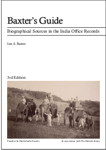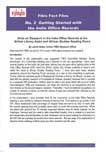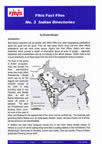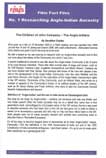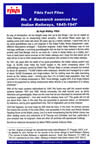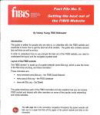Research guides reading list
Check the The FIBIS Bookshop for availability of recommended titles and more information.
- Axelby, Richard
Science and the changing environment in India, 1780-1820 : a guide to sources in the India Office Records by Richard Axelby and Savithri Preetha Nair; edited by Andrew Cook. London: The British Library, 2010.
The title makes clear that this book is not directed at genealogists or even family historians. Yet such is the massive (but apparently not exhaustive) collection of references included that this book may indeed prove to be a work of significant value to family researchers seeking added information about the circumstances which impacted on their ancestors’ lives and professions in India.
As with defense, administration, planting and trade, scientific enquiry was carried out by men who may have been our ancestors. In David Arnold’s Foreword he points out that from about 1780 scientific study focussed on enhancing the material condition of Indian life through famine prevention, agriculture, and identification of products to benefit British and Indian commerce. This early period of scientific interest was reflected in the formation of the Asiatic Society of Bengal in 1784 by senior EIC military and civil officers.
The introductory and explanatory sections absorb 23 pages, which are followed by these 11 chapters or divisions: 1. Plants and Botanic Gardens, 2. Agriculture, 3. Forests and Forestry, 4. Animals and Animal Husbandry, 5. Geology, 6. Meteorology, 7. Health and Disease, 8. Irrigation and Water Control, 9. Communications and the Built Environment, 10. Ethnography, and 11. Landscape and Topography. Each section starts with a brief introduction and outline of the major subdivisions of that section. These major subdivisions are further divided most often by location, or by specific topic such as plants, diseases etc.
Researchers with Planting ancestors will find the chapter on Agriculture worthwhile. For Indigo Planters, F/4/1277, no.51242 includes lists of plantations and factories with names of their European owners 1829-1830; papers re Land Grants for Coffee Cultivation 1827-1831 can be found at F/4/1398, and of course there are numerous references to Tea cultivation. We learn that Soldiers were encouraged in gardening as “Prizes awarded to the men who have been the most industrious and successful in the cultivation of barrack and soldiers’ gardens in the Bengal Presidency 1856-1857” can be found at F/4/2685 no.186678 and F/4/2695 no.191082. Chapter 7 on Health and Disease covers the whole range of hospitals, sanatoriums and asylums, including lunatic asylums, in which respect reference is made to “Returns of public patients (European and native) treated at Bhawanipur and Dullunda asylums from 1840-1858” to be found in P/13-P/15. Chapter 6 on Meteorology is valuable for its references to extreme weather events such as cyclones in which our ancestors may have been caught up or lost their lives.
The concluding part is an amazing 43 page index which makes the entire contents very accessible. It includes many personal names.
Clearly this is not a reference source for the beginner, but for the advanced researcher who enjoys browsing printed matter or who is seeking more depth about their ancestor’s lives on the sub-continent, and is able to attend the British Library in person. (reviewed by Sylvia Murphy)
- Bailey, Peter
Researching ancestors in the East India Company's Armies. [s.l.]: Families in British India Society, 2006. (FIBIS research guide; 1)
The essential handbook for anyone researching ancestors who were connected to the HEIC Armies of Bengal, Bombay, and Madras. It covers records from the armies' origins until their assimilation into the British Army by 1860. Laid out in a clear and accessible manner, the book directs searchers to records on all available stages of a man's career, whether officer or soldier, including sources which may provide details on his wife and children. For those researchers not fortunate enough to have access to the India Office Records at the British Library, the LDS film numbers are included. A full review by Richard Scott Morel, Archivist of Pre-1858 India Office Records, is available on pp. 45-46 of the FIBIS Journal 17 (Spring 2007)
- Baxter, Ian A.
Baxter's guide : biographical sources in the India Office Records. 3rd ed. [s.l.]: Families in British India Society in association with the British Library, 2004
This is the bible for all who are researching ancestors in British India and South Asia. The information sought will probably be found in the India Office Records, which occupy 15 km of shelving hidden away in the basements of the British Library. Thankfully, the author provides invaluable guidance on exactly where relevant information may be located for more than forty different categories of people. The reader is also directed to published sources. If confronted by an obscure term while researching, for instance on learning that an ancestor was a clerk in the Sadr Faujdari Adalat, then 'The glossary of terms used in the administration of British India' towards the end of this guide will be enlightening.
- The British overseas : a guide to records of their births, baptisms, marriages, deaths and burials available in the UK. Geoffrey Yeo. 3rd ed.
London: Guildhall Library, 1994 (Guildhall Library research guide; 2)
Even though some of these records may now be available through the internet, this book is still of use to researchers based in, or able to visit, the United Kingdom.
- Getting started with the India Office Records. Weybridge: Families in British India Society, 2009 (FIBIS fact files; 2)
Planning your first visit to the British Library? This very practical booklet contains two articles which will reduce stress and possible frustration when beginning research in the India Office Records at the British Library in London. Lawrie Butler was the former FIBIS Research Officer and his helpfully illustrated article Hints on research in the India Office Records at the British Library Asian and African Studies reading room carefully sets out what can be accomplished before visiting the library, how to gain admission to the library, and what to do once you enter the reading room in order to obtain maximum results. Elaine MacGregor's article First visits to the OIOC by a 'newbie' is a useful case study recounting her experience of using the same reading room. Both articles were previously published in the FIBIS Journal.
- McLaughlin, Eve
Reading old handwriting. 3rd augmented ed. Haddenham, Bucks.: The author, 1995 (A McLaughlin guide)
Brief but extremely helpful to someone who is new to reading original records. The sample alphabets for various periods are invaluable, as is the section on common abbreviations which includes Christian names which are regularly shortened.
- Morgan, Richard
Indian Directories. London: Families in British India Society, 2009 (FIBIS fact files; 3)
This booklet provides an invaluable guide to the printed directories available on people who lived or served in British India, with examples of the kind of information useful to family historians to be found in them. Written by Richard Morgan, whom many will know from his articles in family history journals on genealogical research relating to India, it is in his characteristically brisk and down-to-earth style, and full of practical advice on how to get the best out of these important sources. In particular he draws attention to the sometimes underestimated Thacker's Indian Directory which so often comes to the rescue when your ancestor was a 'non-official' and therefore omitted from almost all the official records. All the directories discussed are readily available at the British Library and directions are given on locating them elsewhere. (reviewed by David Blake, FIBIS Trustee)
- Researching Anglo-Indian ancestry. Weybridge: Families in British India Society, 2009 (FIBIS fact files; 1)
Essential for any family historian with blended ethnicity. The booklet contains two expanded and updated articles previously published in the FIBIS Journal: The children of John Company : the Anglo-Indians by Geraldine Charles, and A Luso-Indian voyage by Cliff Pereira. These two authorities provide invaluable information: definitions of the various terms used for those of mixed race in the Indian sub-continent, a brief background history of these communities, reading lists, and, by using their own families as a basis, a demonstration of how to effectively research Anglo-Indian ancestors.
- Spencer, William
First World War army service records : a guide for family historians. 4th ed. Kew: The National Archives, 2008
This invaluable guide to locating information on ancestors who served in WW1 has been expanded and updated to refer to many resources which are now available online. The primary source is still the National Archives (TNA) at Kew in England, where in addition to the more obvious Records of Service (British Army officers and other ranks, RAF, WAAC, auxiliary and nursing services) are those of the Indian Army and Dominion Forces. This directs the family historian to a possible treasure trove of records, including those for medals and awards, prisoners of war, unit war diaries and maps.
- Wilding, Hugh
Research sources for Indian railways, 1845-1947. London: Families in British India Society, 2009 (FIBIS fact files; 4)
Inspired by the discovery that a great grandfather had been an employee of the Indian Railways, the author has over the past fifteen years made himself thoroughly acquainted with all UK sources for researching ancestors connected with the Indian railway system. After an introduction which includes an article by Anthony West, another FIBIS researcher in this field, Wilding provides comprehensive lists of the relevant UK archives covering not only the India Office Records, but also The National Archives, the Institution of Civil Engineers, the Institution of Mechanical Engineers, and the Centre of South Asian Studies. There is also a very full book list, a glossary, and – something which has probably never before been attempted – a complete finding list of railways known to have operated in India between 1853 and 1947. (reviewed by David Blake, FIBIS Trustee)
- Young, Valmay
Getting the best out of the FIBIS website. New rev. ed. London: Families in British India Society, 2011 (FIBIS fact files; 5)
This latest title in the series of handy guides being produced by the Families in British India Society has already gone to a second updated edition. It is written by the FIBIS Webmaster "for people who are new to, or unfamiliar with, the FIBIS website and would like to know how to get the best out of its content." As this award winning website offers considerably more than the database and Wiki, the clear explanations of the latest features such as social networking will enable users to discover all its treasures.

